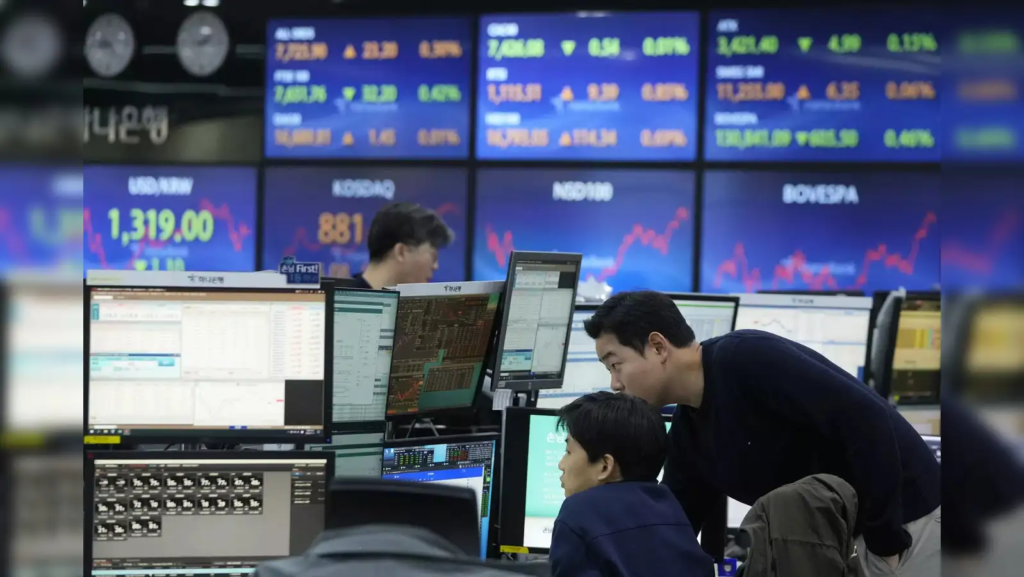The United States economy stumbled more than expected in the first quarter of the year, with gross domestic product (GDP) falling under pressure from an expanding trade deficit. This sudden dip has caused concern among global investors and economists, as trade imbalances continue to shape economic trajectories across major nations.

According to the U.S. Commerce Department’s latest report, the GDP grew at an annualized rate of just 1.3%, down from the previous estimate of 1.6%, signaling a broader slowdown than earlier forecasts.
More on GDP estimates by the Commerce Department
Trade Deficit Widens, Hitting Growth Harder Than Expected
The primary reason for the GDP downgrade lies in the growing trade deficit. In simple terms, a trade deficit occurs when a country imports more than it exports. The gap between U.S. exports and imports grew larger than anticipated, cutting into overall national output.
Imports surged as businesses stocked up on foreign goods, while exports fell due to weaker global demand for American products—particularly in the industrial and tech sectors. This imbalance carved a deeper hole into the GDP than economists had predicted.
Consumer Spending Still Strong, But Not Enough
Despite the fall in GDP, consumer spending—which makes up nearly 70% of U.S. economic activity—remained solid. Americans continued to spend on both services and goods, driven by a strong labor market and moderate wage gains.
However, economists noted that even strong consumer demand wasn’t enough to offset the weight of the trade imbalance. It’s also worth noting that inflation is slowly eating into consumer purchasing power, limiting the long-term growth potential of this spending surge.
Explore more data on U.S. consumer spending
Business Investment Slows Amid Global Uncertainty
Another area of concern is business investment, which showed signs of slowing. Companies became more cautious about investing in new projects, expansions, and technology upgrades. Analysts link this slowdown to uncertainties over global supply chains, fluctuating interest rates, and ongoing geopolitical tensions.
For businesses heavily reliant on exports or global sourcing, the widening trade deficit has introduced more unpredictability in operational costs and long-term planning.
Federal Reserve Watching Closely
The drop in GDP comes at a time when the Federal Reserve is closely monitoring economic performance to decide on interest rate policies. While inflation is cooling gradually, the economic slowdown may pressure the Fed to keep interest rates stable rather than tightening them further.
Some market experts argue that the latest GDP figures could push the Fed to adopt a more dovish approach in the coming months, especially if trade issues persist and business activity remains flat.
Read the latest updates from the Federal Reserve
Impact on Global Markets and Trade Relations
The U.S. is not operating in a vacuum. The trade hit impacting its GDP also reflects a wider shift in global trade dynamics. Other nations, especially China and the European Union, are witnessing slower export growth as global demand weakens.
As the world’s largest economy, the U.S. plays a pivotal role in global supply chains and demand cycles. A slowdown in U.S. GDP can lead to ripples across international markets, impacting everything from commodity prices to currency valuations.
Economists Urge Structural Reforms
With the trade deficit putting pressure on economic growth, economists are calling for structural reforms to make the U.S. more competitive globally. Suggestions include diversifying export markets, strengthening domestic manufacturing, and investing in trade diplomacy.
“We need long-term strategies to balance our trade without relying too much on consumer spending,” said a senior economist from Moody’s Analytics. “The short-term fall in GDP should serve as a wake-up call.”
What This Means for American Workers
While GDP numbers may seem far removed from everyday life, they often impact job security, wage growth, and inflation. A shrinking economy can lead to cautious hiring by companies and even job cuts in vulnerable sectors like manufacturing and logistics.

Fortunately, the current labor market remains resilient, but economists warn that continued trade-related pressures could start showing up in employment figures later this year.
Looking Ahead: Can Growth Rebound?
The future of U.S. economic growth now depends on multiple factors—trade policies, interest rate decisions, consumer confidence, and the health of global markets. If export demand revives and inflation continues to ease, GDP could bounce back in the second half of the year.
However, if the trade imbalance continues to grow, the U.S. might face prolonged slow growth periods, making it harder to sustain job gains and investments.
Conclusion
The fall in U.S. GDP due to a larger-than-expected trade deficit highlights how tightly interconnected global economies have become. While strong consumer spending offers some cushion, it’s clear that America’s economic future depends on resolving deeper structural issues in trade and investment.
Policymakers and business leaders must work together to navigate this critical juncture. As the U.S. charts its course in the global economy, every decision will carry ripple effects far beyond its borders.
World Bank global economic outlook and projections
Also Read – U.S. Jobs Are Booming in 2025—Are You Ready?






